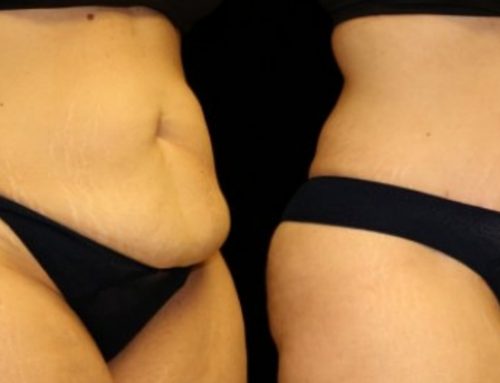Ready for that six pack? Well slow down just a minute. You are well on your way after your tummy tuck, but you’ve just had major surgery and your focus for the short term needs to be on healing, not crunching.
Below is a week-by-week rundown of what you can expect after abdominoplasty, aka tummy tuck surgery. It’s true that everyone is different, but this will give you an idea of an average recovery.
Immediately After Your Tummy Tuck
Immediately after surgery, your tummy will feel tight. Most patients walk slightly bent over for the first few days due to this tight feeling. There are multiple layers of sutures in place under your skin that hold the incision together. Too much pulling or stretching from trying to force youself to stand straight up or lay flat could cause your incision to open up. This is an exceedingly rare complication, but it’s an important reminder not too push too hard too soon.
In addition, Dr. Slack uses progressive tension sutures, which distribute the tension across a much broader area by sewing the skin down in multiple places to the abdominal wall. This takes tension off the incision line which helps decrease pain and increase your ability to move around.
Progressive tension sutures also help prevent seromas from forming. Seromas result when fluid accumulates between the abdominal wall and the skin. Without the progressive tension sutures, drains must be placed to remove this fluid accumulation. Dr. Slack does not use drains, but some plastic surgeons do. You will want to clarify this when choosing who will perform your tummy tuck.
Week 1 After Your Tummy Tuck
The first three to five days are the most difficult period of tummy tuck recovery. You will spend much of this time reclining – often even sleeping in a recliner. During this first week when the pain is most severe, Dr. Slack will prescribe a combination of narcotics and muscle relaxers. A new, long-acting medication called Exparel can be injected into the surgical site as well to numb the area. It’s effects typically last 2-3 days after surgery and is now used by Dr. Slack instead of a pain ball. The hospital or surgery center will charge for using Exparel, but the benefits in initial comfort are well worth the additional cost.
The development of blood clots is a concerning risk after many surgeries, including tummy tuck. This is due to the length of surgery and the decreased mobility during recovery. One important way to help minimize the risk of blood clot formation is to get up and move after surgery. This does not mean walking around the block or running a marathon but simply making yourself get out of bed 2-3 times a day to walk around inside your house. This, in addition to getting up to go to the bathroom and doing specific leg exercises while in bed will lower your risk for blood clots. While it is difficult, due to pain, to get in and out of bed or a recliner, most patients say that once they get up they can walk around fairly well, even if they bent over a bit. Because you will have pain and possibly be taking narcotic medications, it is important to have someone available to assist you as you get up and down from your bed or chair and move around your home.
Here is a video of one of patients 3 days post Abdominoplasty
Week 2 After Your Tummy Tuck
After the first few days to a week, your pain should decrease. You will be able to stop taking narcotics and switch to over-the-counter pain relief medications. Moving around will be much easier for you. However, noticeable swelling will remain through the second week, as you are still healing. Enjoy feeling better, but don’t overdo it!
Weeks 3-6 After Your Tummy Tuck
At the end of that second week, you will feel much more like yourself. If you have a job that isn’t physically demanding you will probably be cleared to return to work and may start to drive again. You will also be able to get some exercise – but no crunches or ab work just yet. You will want to avoid core work for several more weeks. Your surgeon may okay getting out for a brisk walk or other low impact exercise.
As you enter your third week of recovery, much of the swelling will just be starting to go away. This is a slow process that does not happen overnight. Tummy tuck patients are usually concerned by excessive fullness in their lower abodomen during these early weeks. The cause of this is normal swelling, and it will come and go for various reasons. Typically it takes 2 months for most of the swelling to resolve and 6 months for all of it to go away. A compression garment will help conrol the swellling. This will make you feel and look better and also help as you move around, but it won’t make the swelling go away. Only time will do that. Remember you will be feeling better by the end of the second week but you won’t look as good as you would like until 2 months after surgery. So be patient.
Weeks 6 and on After Your Tummy Tuck
This is when you can start to get back to your (new) normal life. Most of your swelling will be gone, and your surgeon will probably clear you to resume normal activity including working out and getting back to more physical employment.
A tummy tuck, like most surgery, isn’t over when the surgeon stitches you up. What happens during the days and weeks immediately following surgery is key to achieving the best results and avoiding unpleasant complications. We know you look forward to get to the gym to work on a fantastic six-pack. But give your body time to do it’s job healing. There will be plenty of time for crunches in just a few weeks.
Tummy Tuck Results: Before and After Photo

For more before and after photos of our Tummy Tuck (Abominoplasty) patients, click here!





